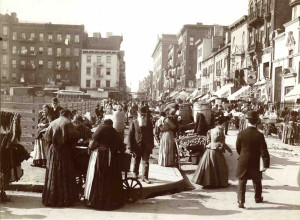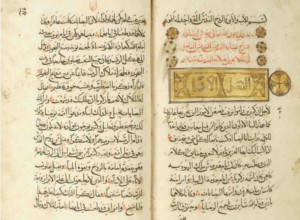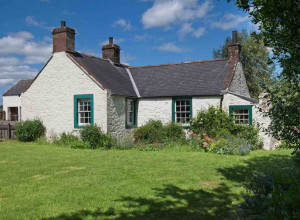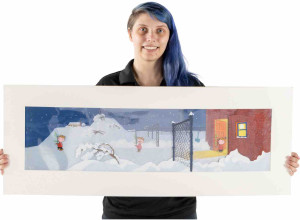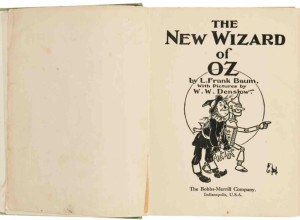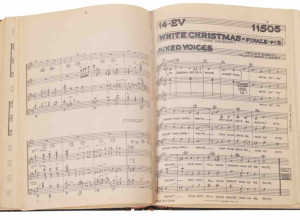From Codex to the Antiquarian Book Fair
After three days at
CODEX, I attended my first ABAA book fair. I had dragged my suitcase, to which
now were added several bags stuffed with CODEX treasure, onto the tour bus that
took us into San Francisco. I figured it would be easy enough to get from our
last stop, the San Francisco Center for the Book, to the hotels reserved for
visitors to the 42nd California International Antiquarian book fair.
This sensible-sounding plan proved somewhat harder to execute, as the hotels
were nowhere near the Center for the Book, and cabs were not easy to come by at
rush hour. Welcome to the big city.
The next day, running a low fever from
exposure to exotic West Coast microbes, I met Scott Brown at the fair, held in a
cavernous exhibition hall, unfortunately not within walking distance of any
of our hotels. Scott was there with Bob Jackson, a Cleveland lawyer and book
collector, whose vast collection of "parts" (serialized Dickens, Trollope, and
others) by now add up to more than a whole. Jackson didn't appear to be buying
(I think he already owns everything) but he got a warm greeting from many of the
dealers who'd sold to him over the years. Scott introduced me around,
warning me that Fine Books' digital incarnation might not be the easiest sell.
But nobody berated
me (not in that privileged company!) and so my main difficulty was wishing I
were tucked into bed with a cup of green tea and a first edition New Yorker
magazine. It was terrible weather--windy, with driving rain, which perhaps
accounted for a small turnout, and the next morning--more rainy cold
weather--the crowd also seemed sparse. Still, a lecture by Nicolas Barker,
editor of recent editions of John Carter's classic ABC for book collectors, was
fully attended, and I don't want to draw any conclusions from the couple of
hours I was able to remain vertical. I will call some dealers and give a
balanced report on the fair in my editor's note.
The most important thing to convey is that whether or not sales were good, visiting one of these fairs for the first time is an uncanny experience. Walking along past rows of books you've read or heard about all your life is a bit like seeing a movie star in the street and thinking: "Oh, I know this person," then realizing, "Oh, no I don't, I've just seen this person on the screen a million times." Here were jackets of books by William Burroughs, John Updike, Hunter Thompson, Saul Bellow and Norman Mailer, jackets I so well remember seeing (and in many cases owning) when I was growing up. So now these jackets are worth something! (Which means I am now old enough to be eligible to become a classic, if only more people would read me.) I gawked at a first-edition copy of Baudelaire's Les Fleurs du Mal, the subject of my senior thesis in college, and had to be prodded into turning the hand-cut pages by the French bookseller who so casually held it out to me. But, interestingly, while I found it intimidating to hold centuries-old books in my hands (even if recently washed), it was anything but intimidating to see great works of literature on display. Because while these may not be books we can afford, these are the books we all know. Even those of us (ahem) who spent much of our formative youth in a bar, or going to parties. These are called "the great books" for a reason. We know these books, those of us with liberal arts educations. These books shaped our minds and yes, sorry, but it's true--these books changed our lives. At least they did mine.
The most important thing to convey is that whether or not sales were good, visiting one of these fairs for the first time is an uncanny experience. Walking along past rows of books you've read or heard about all your life is a bit like seeing a movie star in the street and thinking: "Oh, I know this person," then realizing, "Oh, no I don't, I've just seen this person on the screen a million times." Here were jackets of books by William Burroughs, John Updike, Hunter Thompson, Saul Bellow and Norman Mailer, jackets I so well remember seeing (and in many cases owning) when I was growing up. So now these jackets are worth something! (Which means I am now old enough to be eligible to become a classic, if only more people would read me.) I gawked at a first-edition copy of Baudelaire's Les Fleurs du Mal, the subject of my senior thesis in college, and had to be prodded into turning the hand-cut pages by the French bookseller who so casually held it out to me. But, interestingly, while I found it intimidating to hold centuries-old books in my hands (even if recently washed), it was anything but intimidating to see great works of literature on display. Because while these may not be books we can afford, these are the books we all know. Even those of us (ahem) who spent much of our formative youth in a bar, or going to parties. These are called "the great books" for a reason. We know these books, those of us with liberal arts educations. These books shaped our minds and yes, sorry, but it's true--these books changed our lives. At least they did mine.





